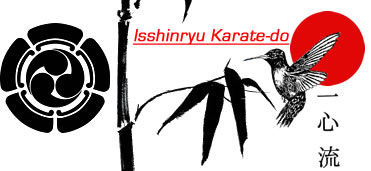
 |
| HOME |
The American dojo? Should we use the terminology? Should we conduct ourselves in the training hall, dojo, using Asian customs and courtesies? What belt system should be used in the United States vs. Japan vs. Okinawa, etc.? Is the karate uniform a necessary or required item in American/U.S. empty hand training/practice? There seems to be a great deal of confusion and misinformation in regards to all these questions. I practice a form of empty hand training/practice that comes from Okinawa. It is a fairly new version of empty hand fighting art or practice which we brought over from the island by Military folks. I hope to answer these questions as I see it. I want to emphasize that I used a lot of what I call Japanese Karate terms/terminology as well as some of what I believed at the time were correctly practiced and executed customs and courtesies. I can tell you that before these last ten years - I used them and believed them an intricate part of learning the Okinawan fighting art of karate and kobudo but have since reevaluated my beliefs and thus my philosophies in practice/training and teaching. |
There are many "things" in American dojo which I believe are incorrect, insulting, and unnecessary except to create a false impression on perspective applicants/practitioners to induce them to pay and join, etc. I also believe it stems from the mysticism that permeates the current karate or martial art system in the United States. We tend to desire "stories" that stimulate our ego's into believing in something rather than accepting life as nature intended. We have to much time, idle time, on our hands and this leads us to seek out purpose and fill our lives with such things that avoid boredom, etc. This may be one of the many reasons I believe that karate training provided today is re-tooled to present participants the "instant gratification" that is promoted today by technology and the desire to avoid boredom, the day-to-day humdrum of every day life. We are so wrapped up in past or future events we fail to appreciate our present moment life. The monkey brain takes over and tells us that we need this stuff to be happy and we seek to avoid the pain of life which is necessary to balance it out. The repetitive practice of karate is one aspect that this tool provides, if practiced this way, that allows is to see and feel the benefits of the ritualistic way and to center us into the present moment. One aspect that promotes proficiency and a way to achieve a better life. |
We have "reishiki" or the etiquette that someone witnessed one time that has been incorporated into the dojo. This etiquette led to the dojo configurations that are not Okinawan traditionally. Such things as the shoman with joseki. Shoman is the wall of honor (specifically references the front wall) and joseki is that alter (kamidana) configuration (specifically the high point of the dojo) that is zen or buddhist in nature which stems from that practice in Japan which because it is a part of the society customs and courtesies is in the Japanese dojo which does not equate to dojo requirements but a custom and courtesy that their society dictated. Then there is this issue of bowing at the drop of a hat, the regimentation and structure of the training and practice that seems to stem from not only the Japanese society structure but also from influences of the American military. We cannot forget that the basis of all karate training in the United States is directly from the military who brought it home and opened the first training facilities. A great deal, as I have mentioned, is correlated to the economic issues as well as "giving the customer what they desire" to achieve levels of support that comes from applicants, to participants, to those aspects that generate income. Income is the key word followed closely by mystique to peak the interest and inspire one to spend hard earned cash to receive instruction. |
I have addressed some of these issues in the page Etiquette. I will stress here again that we all should be practicing and teaching as Americans. We should drop all the hoopla and create our own unique way of teaching, practicing, and training in the art of the empty hand. We should separate all the stuff lumped under the heading karate and provide appropriate knowledge and experience in each specialty so that all who provide such services are fully vetted, fully certified to conduct training as it should be done. Maybe this tact will lead to validation by society and that they will take it seriously. It is imperative that the dissimilarities of systems and styles are bound together through the fundamental principles of martial arts. All systems and styles have the core principles that are the same yet the system and styles implementation can be unique. |
| NOTICE: "The Author, it must be remembered, writes from his own standpoint!" |